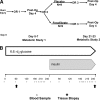Insulin sensitivity and mitochondrial function are improved in children with burn injury during a randomized controlled trial of fenofibrate
- PMID: 17245174
- PMCID: PMC1876998
- DOI: 10.1097/01.sla.0000250409.51289.ca
Insulin sensitivity and mitochondrial function are improved in children with burn injury during a randomized controlled trial of fenofibrate
Abstract
Objective: To determine some of the mechanisms involved in insulin resistance immediately following burn trauma, and to determine the efficacy of PPAR-alpha agonism for alleviating insulin resistance in this population.
Summary background data: Hyperglycemia following trauma, especially burns, is well documented. However, the underlying insulin resistance is not well understood, and there are limited treatment options.
Methods: Twenty-one children 4 to 16 years of age with >40% total body surface area burns were enrolled in a double-blind, prospective, placebo-controlled randomized trial. Whole body and liver insulin sensitivity were assessed with a hyperinsulinemic-euglycemic clamp, and insulin signaling and mitochondrial function were measured in muscle biopsies taken before and after approximately 2 weeks of either placebo (PLA) or 5 mg/kg of PPAR-alpha agonist fenofibrate (FEN) treatment, within 3 weeks of injury.
Results: The change in average daily glucose concentrations was significant between groups after treatment (146 +/- 9 vs. 161 +/- 9 mg/dL PLA and 158 +/- 7 vs. 145 +/- 4 FEN; pretreatment vs. posttreatment; P = 0.004). Insulin-stimulated glucose uptake increased significantly in FEN (4.3 +/- 0.6 vs. 4.5 +/- 0.7 PLA and 5.2 +/- 0.5 vs. 7.6 +/- 0.6 mg/kg per minute FEN; pretreatment vs. posttreatment; P = 0.003). Insulin trended to suppress hepatic glucose release following fenofibrate treatment (P = 0.06). Maximal mitochondrial ATP production from pyruvate increased significantly after fenofibrate (P = 0.001) and was accompanied by maintained levels of cytochrome C oxidase and citrate synthase activity levels. Tyrosine phosphorylation of the insulin receptor and insulin receptor substrate-1 in response to insulin increased significantly following fenofibrate treatment (P = 0.04 for both).
Conclusions: Fenofibrate treatment started within 1 week postburn and continued for 2 weeks significantly decreased plasma glucose concentrations by improving insulin sensitivity, insulin signaling, and mitochondrial glucose oxidation. Fenofibrate may be a potential new therapeutic option for treating insulin resistance following severe burn injury.
Trial registration: ClinicalTrials.gov NCT00361751.
Figures





Similar articles
-
The peroxisome proliferator-activated receptor alpha agonist fenofibrate has no effect on insulin sensitivity compared to atorvastatin in type 2 diabetes mellitus; a randomised, double-blind controlled trial.J Diabetes Complications. 2014 May-Jun;28(3):323-7. doi: 10.1016/j.jdiacomp.2014.01.001. Epub 2014 Jan 8. J Diabetes Complications. 2014. PMID: 24560135 Clinical Trial.
-
Intensive insulin therapy improves insulin sensitivity and mitochondrial function in severely burned children.Crit Care Med. 2010 Jun;38(6):1475-83. doi: 10.1097/CCM.0b013e3181de8b9e. Crit Care Med. 2010. PMID: 20400899 Free PMC article. Clinical Trial.
-
Role of the PPAR-α agonist fenofibrate in severe pediatric burn.Burns. 2012 Jun;38(4):481-6. doi: 10.1016/j.burns.2011.12.004. Epub 2012 Jan 9. Burns. 2012. PMID: 22226866 Free PMC article. Review.
-
Improvement of insulin sensitivity after peroxisome proliferator-activated receptor-alpha agonist treatment is accompanied by paradoxical increase of circulating resistin levels.Endocrinology. 2006 Sep;147(9):4517-24. doi: 10.1210/en.2005-1624. Epub 2006 Jun 1. Endocrinology. 2006. PMID: 16740970
-
Role of fat metabolism in burn trauma-induced skeletal muscle insulin resistance.Crit Care Med. 2007 Sep;35(9 Suppl):S476-83. doi: 10.1097/01.CCM.0000278066.05354.53. Crit Care Med. 2007. PMID: 17713396 Review.
Cited by
-
Burn-induced hypermetabolism and skeletal muscle dysfunction.Am J Physiol Cell Physiol. 2021 Jul 1;321(1):C58-C71. doi: 10.1152/ajpcell.00106.2021. Epub 2021 Apr 28. Am J Physiol Cell Physiol. 2021. PMID: 33909503 Free PMC article. Review.
-
The role of hyperglycemia in burned patients: evidence-based studies.Shock. 2010 Jan;33(1):5-13. doi: 10.1097/SHK.0b013e3181af0494. Shock. 2010. PMID: 19503020 Free PMC article. Review.
-
Long-term persistance of the pathophysiologic response to severe burn injury.PLoS One. 2011;6(7):e21245. doi: 10.1371/journal.pone.0021245. Epub 2011 Jul 18. PLoS One. 2011. PMID: 21789167 Free PMC article. Clinical Trial.
-
[Research advances on early enteral nutritional therapy in severe burn patients].Zhonghua Shao Shang Za Zhi. 2021 Sep 20;37(9):880-884. doi: 10.3760/cma.j.cn501120-20210621-00223. Zhonghua Shao Shang Za Zhi. 2021. PMID: 34645155 Free PMC article. Chinese.
-
Mitochondrial vulnerability and increased susceptibility to nutrient-induced cytotoxicity in fibroblasts from leigh syndrome French canadian patients.PLoS One. 2015 Apr 2;10(3):e0120767. doi: 10.1371/journal.pone.0120767. eCollection 2015. PLoS One. 2015. PMID: 25835550 Free PMC article.
References
-
- Wolfe RR. Glucose metabolism in burn injury: a review. J Burn Care Rehabil. 1985;6:408–418. - PubMed
-
- Thorell A, Efendic S, Gutniak M, et al. Insulin resistance after abdominal surgery. Br J Surg. 1994;81:59–63. - PubMed
-
- van den Berghe G, Wouters P, Weekers F, et al. Intensive insulin therapy in the critically ill patients. N Engl J Med. 2001;345:1359–1367. - PubMed
-
- Gore DC, Chinkes D, Heggers J, et al. Association of hyperglycemia with increased mortality after severe burn injury. J Trauma. 2001;51:540–544. - PubMed
Publication types
MeSH terms
Substances
Associated data
Grants and funding
LinkOut - more resources
Full Text Sources
Medical

